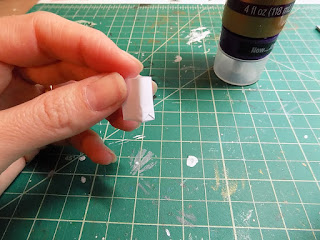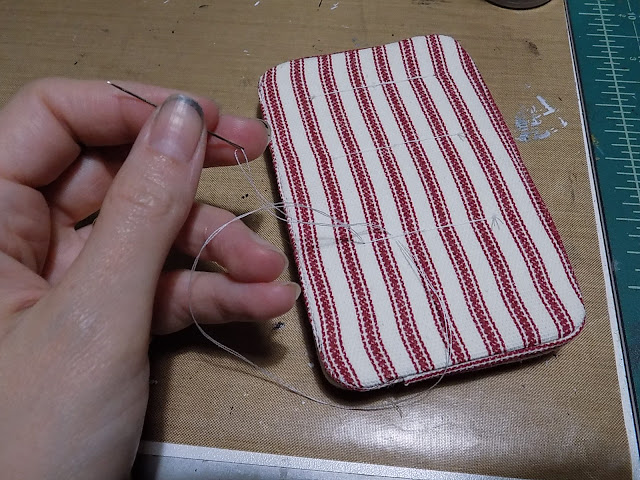This month, the design team for Alpha Stamps was sent a few new die cut playing cards to...well, play around with! The Spider Web Wrought Iron one caught my eye and I decided to transform it into a bed for a witch. My decision to use the spider web card had nothing to do with the need to craft Hallowe'en things, I swear. The table was an afterthought, made by gluing a wood finial to a wood disk, painting it, then adding a Dresden trim along the edge. The table top has an embossed design using a stamp from the Curiosity Cling Stamp set.
The construction is quite simple, and I'm going to show you how to do it. You will need:
Spider Web Wrought Iron Playing Card
Balsa wood approx. 3" x 4 7/8" x 1/4" (bed base. It is the same dimensions as the card)
Basswood Strip 3/16" x 2/16" cut into lengths of the following size:
4" long- cut two (headboard legs)
2 1/2" long- cut two (footboard legs)
3" long- cut two (supports)
Basswood Strip 3/16" wide by 4 13/16" long (side supports)
Scrapbook paper
Saw
Paint
Glue
First, trace around the card back onto heavyweight cardstock/drawing paper/watercolor paper, then scootch the back about 3/16" down and trace around the end again. Cut along traced line. The card back will become the headboard and footboard and the cardstock will later become part of the mattress. The mattress needs to be shorter to accommodate all the bulk. You will have to adjust the length of your mattress if you plan on using thicker fabrics for bed linens. I will have the tutorial for the mattress tomorrow.
Measure 2 3/8" from top of card back and 1 1/2" from bottom of card back. Cut along lines. The larger piece will be the headboard and the smaller, the footboard. Save the middle piece, we need a strip of that for the footboard. Cut the card front using the same measurements. See those two skinny bits? They come in handy if you have to apply glue to something small. Or fold them in half and use them as paper doll stands. Or just throw them on the floor and sweep them up later.
Next, trim off 1/4" from the headboard front. I wanted my headboard to be flush with the bed base, so I trimmed off 1/4" which is the same width (or is it depth?) as the balsa wood I used for the bed base. Because we want the footboard to be nice and tidy, we need to add a piece along the bottom to frame it out. Cut a strip from the saved bit that fits inside the footboard. I eyeballed mine, and it is crooked. Meh.
Paint all the pieces! Including the balsa wood bed base, supports, and legs.
Paper all the pieces! No, not really. Just the headboard and footboard. Ink around the paper edges and add color to the webs if you like.
Next, glue headboard front to headboard back and footboard front to footboard back. Also glue on the extra trimmed bit. See how nice that looks? Grab the bed base and glue a 3" long support to both ends of the bed. (The photo after the next one will show you exactly where to glue the support for the headboard, whereas the footboard support is aligned with the end of the bed base.) Here you see the headboard and legs, footboard and legs, the balsa wood bed base with two support pieces glued on either end, and two additional supports pieces that don't belong in this pic and should be on the floor with the rest of the unusable pieces.

As I said, the headboard support is glued to the bottom of the bed base but with a tiny bit jutting out. The headboard will be resting on this and hopefully make the bed sturdier. The footboard support is glued flush with the other end since I did not want to see the support from the front of the bed. The purpose of that support is mainly to have additional surface area to glue on the footboard, thus making it durable. It makes sense in my head anyway!
Headboard freshly glued flush to bed base and on lip of support.
Footboard glued to bed base.
Okay, now there are probably a thousand better ways to glue on the legs but this is the kooky way I did it. Maybe because it's wine in my mug and not coffee. The bed is 1" from the floor, so I placed it on four 1" cubes and then weighed it down with something heavy. (EasyMold kit worked pretty well!) Glue the 4" long basswood strips to the headboard and 2 1/2" long ones to the footboard.
Lastly, glue 4 13/16" long side supports to both sides of bed. It's a bed!
The bed needed a mattress:
Sheets and a pillow:
And finally, a blanket with a really cool design (courtesy of the All Seeing stamp in the Curiosity Cling Stamp set). I used another one of the stamps to emboss the top of the table. All of the stamps in that set are interesting and will most likely show up in a lot of my projects. Thanks, Leslie!
Supplies List:
Spider Web Wrought Iron Playing Card
Basswood Strips 3/16"
Curiosity Cling Stamp Set
Tiny Antique Silver Crown
10mm Clear Glass Marble
Large White Turquoise Skull
Ceramic Black Cat Bead
Astrology Backgrounds collage sheet
Alchemy Collage Sheet
Tiny Divination Cards collage sheet
Tim Holtz Vignette wood Finials
Thin Looped Dresden Borders- Black
3" wooden disk, bag of balsa wood (assorted sizes), modeling wax, toothpick. Happy crafting to you!


















































